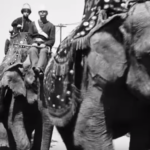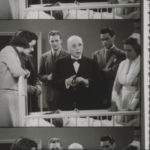The VHS Legacy Can Be Saved, But Will It?
The VHS tape was such a clunky medium that it almost invited disdainful treatment. Never the archivist’s or librarian’s first choice of format, it nonetheless won out in the “videotape format wars” of the late 1970s and 1980s, and became the medium of choice.
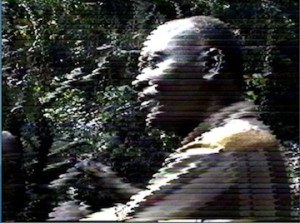
Blurred signals: that way, no nirvana lies.
Its chief competitor, Betamax, while it could boast better image quality, was not without its own problems, including a shorter recording time, and was consigned to the if-only dustbin.
VHS — Video Home System, manufactured by Victor Company of Japan (JVC) — became the medium not only for home viewing, but also for most library film collecting, as well as for much library recording of news broadcasts and other kinds of television programming. Some academic libraries built collections of many thousands of tapes, whose primary role was to support teaching and specialized film research.
The problems with VHS
Now, in the era of digital recording and online streaming, those VHS tapes — like the ones you may well have in a box in your closet — are slowly but surely deteriorating. And before too long they will become as unplayable, and presumably follow commercial VHS rental stores into extinction; at least, you may find that watching VHS tapes is an ordeal of visual dropout (“snow”), audio dropout, color loss, or various other distortions and degradations.
Deterioration of VHS and other magnetic tape occurs due to the way they are made. Sounds and images are registered onto the tape via magnetism, and those signals lose their magnetism, over time. In the case of VHS tape, image and sound issues have had up to 40 years to set in. The format came into wide use when video cameras did, beginning in the 1970s.
Librarians and archivists are increasingly aware that their collections risk becoming irretrievable. That may be particularly true for films that were loaned out often, but that, despite their popularity during the VHS era, were never released commercially on DVD. Often-loaned VHS tapes, in particular, likely spent a lot of time exposed to un-ideal conditions, such as sitting on the sun-heated passenger seats of students’ and faculty members’ cars, or on sofas, underneath borrowers or their jumping kids.
Any VHS tape can be copied into digital form as long as its signals are strong and clear enough, but the process of salvaging the tapes is costly. For starters, labor costs are high because, if the digitization is to be optimal, someone must watch the recording, as it proceeds, to ensure problems aren’t occurring, and that glitches aren’t being reproduced.
Also problematic is that VHS tapes haven’t been commercially marketed in about 15 years, and the machines to play them are becoming scarce, too. Few manufacturers bother with VHS machines, any more, and buying them isn’t easy, unless purchasers are willing to settle for cheap brands sold at big-box stores.
Good-quality machines are becoming particularly difficult to come by in numbers that would be needed to keep library VHS stations up and running.
In any case, VHS stations long ago lost the keen battle for space in academic libraries.
What can be done to save VHS tapes?
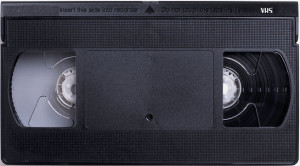 What can be done to stave off the ultimate demise of the VHS? Turns out, something could.
What can be done to stave off the ultimate demise of the VHS? Turns out, something could.
If kept in ideal conditions, VHS tapes last quite a while. Realistically, however, only shifting the content of VHS tapes onto a digital platform is likely to preserve it. Here copyright law comes into play, in a slightly complicated way.
Under copyright law, libraries can’t just make digital copies of VHS tapes (or other, less-common varieties of videotape) and include the digital copies in their collections. You might wonder, why not? The answer is that copyright law is contentious, and lots of money is at stake, so copyright owners — large film-production companies, for example — have long sought to ensure that their financial interests are maximized and secured, generally with the assistance of well-heeled lawyers and lobbyists, and ultimately friends in Congress.
Such influence has been pitched in terms of a need to “strike the appropriate balance between copyright holders and libraries and archives in a manner that best serves the public interest.”
The result of deliberations over the years has been that if librarians want to replace a deteriorating copy of a VHS recording in their collection, they generally need to replace it by purchasing a copy in a more-recent format, such as on DVD or now through online streaming or other digital format.
But of course that is not always possible – an estimated one half of recordings that were available on VHS have not been made available on DVD, and probably never will be, although streaming video presumably offers some hope for those myriad languishing films.
One further avenue to salvation, for at least the content of many commercially released VHS tapes, does exist: Section 108 of US copyright law. It allows — in the interest of that “appropriate balance” — that librarians may preserve the content of VHS tapes, when the commercial market does not. The purpose of Section 108 is to help archivists and librarians protect “content” – films and television programming – from disappearing due to obsolescence of media platforms and machinery to play them.
If librarians have a VHS tape whose content has not been made available on DVD or later format, they may make a digital copy of the VHS.
Three copies, in fact. (The law doesn’t specify what those three copies should be, but they could be, for example, a high-resolution master file, a DVD version, and a streaming file.)
Section 108 further stipulates that the three copies may be made solely for the purpose of replacement of a recording that is damaged, deteriorating, lost, or stolen, or in an obsolete format. (In a sense, VHS tapes began to deteriorate as soon as they were made, but copying VHS tapes on that basis would no doubt stretch the tolerance of the law.)
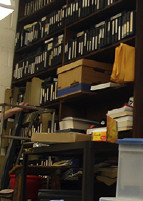
Neglected video collections — many campuses have them.
108’s permission comes with two other provisos: Before copying a VHS tape, libraries and archives must make a “reasonable effort” to determine “that an unused replacement cannot be obtained at a fair price,” and, once they make copies, they generally must not allow the copies to be shown in public outside the library or archive. (“Generally,” because libraries are allowed to make “fair use” of their holdings, for various purposes — there lies another also-complicated, and also-contentious, area of copyright law.)
Section 108 was enacted as part of the Copyright Act of 1976, then amended in 1998 by the Digital Millennium Copyright Act and the Copyright Term Extension Act, and in 2005 by the Preservation of Orphan Works Act. The US Copyright Office, a branch of the US Library of Congress, has reconsidered it further, since, without further amending it. But this month [September 2017], the office issued a discussion paper setting out a variety of suggested changes designed “to make it easier to understand and apply.” Among other new allowances, the Office recommends permitting any library or archive to make a “dark archive” – a collection of copies of all the commercially released films in its collection, for safeguarding but not for other uses.
This month’s discussion paper makes the point that, although occasionally altered since its inception, Section 108 essentially views the relevant issues from the perspective of 1976 — a long time ago, in terms of video technology. “The exceptions in section 108 are stuck in time,” says the paper, which the Copyright Office prepared with consultation from a variety of librarians and archivists. “The exceptions did not anticipate and no longer address the ways in which copyrighted works are created, distributed, preserved, and accessed in the twenty-first century.”
The discussion paper notwithstanding, changes will likely be slow coming. Some librarians and archivists, the paper acknowledges, would prefer nothing be done, because they fear change will make a confused situation only more confusing.
Copying doesn’t come for free
Audiovisual content, in whatever form, has a lifespan, an uncertain expiration date. That’s true not only of VHS and other magnetic-tape formats, but also of DVDs, too, because DVDs are being superseded by digital-only formats, and being superseded is almost always a death knell. Even digitization is less than ideal, as a preservation medium, because it, too, can encounter problems, over time, including that computer machinery and software programs are superseded and become obsolete.
But the more immediate problem facing librarians is that if they have a lot of VHS tapes, copying them is expensive. Even selecting which tapes to digitize, after ideally reviewing all of a collection and setting principles of priority, takes a lot of librarian time.
As a result, academic and public libraries are being very cautious as they go about digitizing their VHS collections, or in most cases are simply not addressing the issue; or, at best, they are copying tapes only as a library user requests a particular title that has not been released on DVD. But copying VHS tapes one at a time doesn’t get you very far.
Section 108 “is an incredibly powerful segment of US copyright law,” says deg farrelly, a recently retired video librarian at Arizona State University. But sadly, he says, few librarians seem to be making much use of it.
Two years ago, he and two colleagues set up a national database, the Section 108 Due Diligence Project, whose goal is to permit librarians around the US to cooperatively identify which VHS tapes in their collections can be copied under Section 108 provisions. The project provides a central location for librarians to record details of their “due diligence” investigations of whether particular films — ones they have on VHS — have ever appeared on DVD, and whether those DVDs, or even good copies of VHS tapes, are available for a “reasonable price.”
The project offers a handy way for librarians who have made such determinations to share that information with colleagues at other institutions so that their colleagues, too, can legally make digital copies of tapes they have in the collections.
In theory, all libraries and archives could band together to create one huge data base of every VHS they have. Could they then share the work of making digital copies of films that are not available on DVD or in some digital form, and share those with other libraries and archives that also hold copies of the films?

deg farrelly
“This is where librarians would have to push the envelope, a little bit,” farrelly says. He believes the law would protect them, as long as they own a copy of any title they make or receive. “The law doesn’t say that a library has to make its own copy,” he says.
In any case, he says, “the risk is very low, because we’re talking about content that is out of distribution, that is not commercially available.
“The only problem this could create: a distributor, a copyright holder could come forward, and say ‘maybe there’s a market for this, and you’re diminishing my market by making these copies available.’ But that can be handled on a case-by-case basis.”
He says a librarian could simply say, “OK, good, we’ll take it out of the database.” And, of course, librarians to whom the copying librarian has sent copies could take those out of circulation.
For a variety of reasons, librarians and archives have not jumped on the opportunity. In addition to likely timidity about going out on a Section 108 limb by sharing digitized copies, they have financial reasons for hesitating.
To date, the database has 2,657 titles, which is to say that it is far, far short of complete. Only 14 academic libraries have contributed information to it, and of those, only 4 have certified the Section 108 status of more than two titles.
The database’s keeper, Chris Lewis, a media librarian at American University, says many librarians are intimidated by the requirement that they must thoroughly search for a distributor or other source of a replacement copy. Hopefully, he says, that fear will dissipate as the database grows, and becomes better known.

Chris Lewis; photo: American University
The search requirement is hardly arduous, he notes. Librarians are on safe Section 108 ground as long as they search the sales catalog or web site of a VHS release’s original distributor; contact the original distributor to ask whether it or some other company is still distributing the film; search major databases of library holdings such as WorldCat, to see if the film has been reissued, perhaps under a different title; and, most simply of all, search major online marketplaces of new films on DVD, and for that matter on VHS. Amazon, for example.
If a title is in the VHS due-diligence project’s database, all that work has already been done.
To be sure, institutions have plenty of work to do, because they need to run those checks for every single VHS tape they hold. His own priority, at the moment, is less to publicize the Due Diligence Project than to get all of his own library’s out-of-distribution holdings onto the database — “before I can spend a lot of time urging others to get involved,” he says. “Not that I am not making some effort but it’s important to me that we get our data available, first.”
He is well aware, he says, that his colleagues at many institutions face a bigger issue: “Administrators just don’t care about VHS; they’re not worried about it. In my opinion, they view them as being dusty old tapes in a closet. They think the content on them is outdated, or something. And they’re not sexy, in any way, so getting money to pay for it… That’s why we’ve just had to do it on a shoestring.”
He and his colleagues at American University haven’t digitized their VHS tapes so cheaply that the results are inadequate: “We’ve built a good workstation, with Final Cut Pro, we’ve got various things, to do this at pretty much archival level, even though an archivist would say, ‘Well, you’re not doing it uncompressed…’ But we say, ‘Well, but you’re not doing it, at all.’”
He urges colleagues to bear in mind that, as their VHS tapes age, machines to play them on, and record them from, do, too. VHS players have various moving parts made of rubber and nylon that dry out and flake off and gung up machines, so they need to be maintained and repaired by technicians who knows what they’re doing.
Will 3D printing of parts offer a way out of the VHS-player challenge? In theory, perhaps, but in practice?
Adding to the unlikelihood of a wholesale rescue of VHS tapes, or anything like one, is that video librarians are themselves a dying breed. They were in their heyday in the 1990s and 2000s, but now many of the leading figures in this area of collecting are retiring, and libraries are not replacing them.
As many of his peers approach retirement, Lewis says, they unsurprisingly run out of time and energy to take care of the collections, themselves. So, he says, “they’re leaving it for the people who come afterwards who have no sense of the value of them.”
Often, he says, colleagues ask him “‘Do you know where I could recycle my collection?’”
Farrelly tries to be optimistic about the prospects, but says: “American libraries do not have a very good track record on preservation issues,” in regards to video or any other audiovisual medium.
Lewis sounds a similar note: He says he expects that eventually “there will be point where there will be a little bit of a critical mass. But I don’t think it’s going to be everywhere because there’s that general feeling about VHS.
“If you look at the things that we protect, it tends not to be studio movies that are classics but are forgotten. But there’s a lot of PBS [Public Broadcasting Service] content, and I think there will definitely be some uptake, but it’s not going to be huge.”
— Peter Monaghan
Previous Post: Streaming Video: A Library Staple for Modern Times



